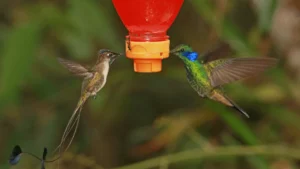Marvelous Spatuletail, we know This incredible hummingbird as the Magnificent Spatuletail.
Magnificent Spatuletail can only be found in a small area of Peru. It’s easily recognizable with its long, split tail and two vibrant blue feathers with black tips.
These feathers give the bird its name and make it one of the most eye-catching hummingbirds!
If you’re fortunate enough to spot this bird in its natural environment, it’s stunning.
Let’s dive in!
Are the Marvellous Spatuletail Endangered?
The IUCN has declared the Magnificent Spatuletail an endangered species.
Unfortunately, its habitat is in danger because of loss and damage and the harsh effects of climate change.
Conservation groups are joining forces with local communities to create protected areas and promote sustainable land use to safeguard the Magnificent Spatuletail and its habitat.
Researchers are also studying the bird’s ecology and behaviour to find out more and ensure conservation efforts are practical.
What does marvelous Spatuletail look like?
At just 12 cm long, the Magnificent Spatuletail is a tiny bird but beautiful!
The male’s back and head are a brilliant green, and its white chest and belly complete the look.
The real showstopper is its long forked tail with two bright blue spatula-shaped feathers and black ends.
When courting, the male fans put their tail feathers and wave them around to woo a potential mate.
The female Magnificent Spatuletail is not as flashy as the male – her green is more muted on her back and head, and she’s got white on her breast and belly.
She’s also missing the males’ spatula-shaped feathers on her tail, which is shorter than the males.
Although it looks very different from other birds, only a few people outside birdwatching circles have heard of the Marvelous Spatuletail.
That’s partly because it only lives in a few areas in the cloud forests of Peru, so it’s rare.
What do Marvellous spatuletail eat?

These amazing Marvelous Spatuletail love sipping nectar from bright, fragrant flowers, like Peruvian Lilies and “mupa mupa” tree blossoms.
This amazing spatuletail forages exhilaratingly, moving among numerous flowering plants and stopping to eat.
Spatuletail frequently consumes food from a red lily (Bomarea formosissima), but it also consumes up to five other flowering plants such as niger seeds. which is also a favourite food of many others.
It has to compete with other hummingbirds from the same area for food, which it usually cannot win.
Not only do they get to enjoy delicious nectar, but they also play an essential role in pollination.
Suggested:
Where does the marvelous Spatuletail live?
The Incredible Spatuletail bird can only be spotted in the cloud forests in northern Peru.
These forests are kept misty, which is excellent for the plants that the Incredible Spatuletail eats.
It lives between 1500 and 3000 meters above sea level.
Unfortunately, the home of the Magnificent Spatuletail is in danger because of deforestation and human activity.
Peruvian cloud forests are being destroyed to make way for farming, mining, and logging, which has caused the Magnificent Spatuletail’s area to shrink and its numbers to drop drastically in recent times.
What is the courtship behavior of marvelous Spatuletail?
The Marvelous Spatuletail is a loner, and it mostly gets its energy from nectar flowers and minor bugs.
It’s like other hummingbirds; it needs to eat a ton to keep up its rapid metabolism.
During the breeding season, the male Magnificent Spatuletail puts on quite the show to try to win over a mate.
Male Spatuletail flies in front of the female, flaunting his tail feathers and buzzing them back and forth. If a female is into it, she’ll let him get lucky.
The female Magnificent Spatuletail makes the nest and caring for the young.
She weaves the nest out of plant fibres and spider webs, then lines it with cosy stuff like moss and lichens.
She usually lays two eggs, which she sits on for around 16 days before they hatch.
The chicks will stay in the nest for a few weeks before leaving.
Final Words
We hope you love this article!
Seeing the Marvelous Spatuletail is incredible – the bright blue feathers shaped like spatulas, plus the fantastic courtship display – it’s truly a sight to behold.
But we’re destroying its habitat with deforestation and other human activities, which puts it in danger of disappearing forever.
We have to act now and work to protect the Magnificent Spatuletail and its home for future generations to enjoy.
Let’s all do our bit to ensure this fabulous bird can survive in the wild.
Thanks!
You’ll also love these:
WHAT DO BIRDS LOOK LIKE WITHOUT FEATHERS | INTERESTING FACTS
